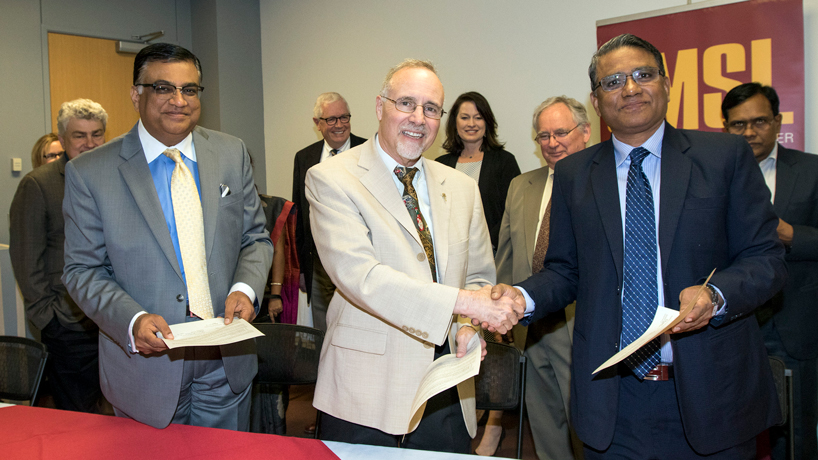
Entrepreneur Deepak Kant Vyas (at left), UMSL Chancellor Tom George (center) and Osmania University Vice Chancellor S. Ramachandram sign documents committing to a partnership between the two universities as others watch on May 19 at the Millennium Student Center. (Photos by August Jennewein)
S. Ramachandram sat down at a table with Tom George and Deepak Kant Vyas in a corner meeting room on the third floor of the Millennium Student Center.
He was to have lunch while nearing the end of a two-day visit to the University of Missouri–St. Louis.
Moments before that meal was served on May 19, the three men – Ramachandram, the vice chancellor of Osmania University in Hyderabad, India; George, the UMSL chancellor; and Vyas, the Indian American entrepreneur who helped bring them together – took turns adding their signatures to a series of documents. Each pen stroke was meant to formalize their shared interest in building a partnership between the two universities.
The hope is that it will originate with the formation of dual degree programs – likely starting in the areas of business, information systems, computer science and biotechnology – and over time grow to include further collaboration.
“The documents say that we’re going to work together to develop these programs,” said Joel Glassman, the academic director of International Studies and Programs at UMSL. “The next agreement will be a more detailed agreement about what we’re actually going to do. This is like a handshake saying the visit went very well, we’re both interested in working together and we’re committed to working together on a wide variety of projects.”
One possibility could see members of UMSL’s Department of Criminology and Criminal Justice providing education and training for police authorities in Telangana, the state in southern India that is home to Hyderabad and Osmania University.
Another could have members of UMSL’s College of Optometry working to help develop an optometry school in that region.
“No agreements were reached,” Glassman said. “This is a long road to getting these things done.”
But Ramachandram’s visit demonstrated how much progress has already been made since Glassman represented UMSL on a visit to Telangana in February.
He joined a delegation of other local leaders from the St. Louis Regional Chamber, the Missouri Partnership, T-REX, BioSTL, GlobalSTL and Webster University.
Vyas, the founder of the St. Louis-based technology company Redberri and a member of the Chancellor’s Council at UMSL, helped fund the trip through his foundation. He has lived in St. Louis for more than 30 years but has deep ties to Hyderabad.
“Each other member of the delegation had slightly different priorities,” Glassman said.
The St. Louis Regional Chamber is reportedly exploring the feasibility of establishing a satellite office in Hyderabad to promote two-way trade and investment.
T-Hub, Telangana State’s startup incubator, has thoughts of establishing a Midwestern U.S. office in T-REX in downtown St. Louis.

The agreement signed by Chancellor Tom George (center) and S. Ramachandram (at right) states their shared intention to form 2+2 degree programs between the two institutions, likely starting in the areas of business, information systems, computer science and biotechnology.
UMSL, for its part, is continually looking to expand its reach around the globe so it can attract more international students.
It’s part of a long-running push that began in the 1990s under the leadership of former Chancellor Blanche M. Touhill and has continued under George, who succeeded her in 2003.
“We’ve had great support for doing this from both Chancellor Touhill and Chancellor George, but it’s not just because they’ve been very international in their perspective,” Glassman said. “It’s because it’s the right time in the development of a mature university for us to be focusing on those kinds of issues.”
UMSL currently has relationships with about 75 universities located in roughly 50 countries. Most are student-exchange relationships, some more active than others.
The university has also played a role in helping found American-style universities in Oman and Kuwait and recently signed an agreement to work with another startup university in Lahore, Pakistan.
It likewise has benefited from the UM System relationship with the University of Western Cape in South Africa.
The budding relationship with Osmania University could be even more significant.
“This is a very big university,” Glassman said of Osmania University, which is home to more than 300,000 students among its different campuses and affiliates. “It’s a very important university in India. It’s a very good thing for our university to have a strategic partnership with such a prominent university.”
One of the next steps in negotiations is likely to be a discussion with the state of Telangana about whether students participating in 2+2 degree programs could be eligible for scholarship money already available. The ability of students to access such funding will be key for Indian students who might wish to come to UMSL to study.
Glassman does not envision many UMSL students going abroad to India because there doesn’t seem to be demand right now.
That is one of many things with the potential to evolve as UMSL and Osmania begin work together. The two universities now have taken important first steps.
“I will be really happy if this partnership matures and develops,” Glassman said. “I think it will. It looks very good.”














